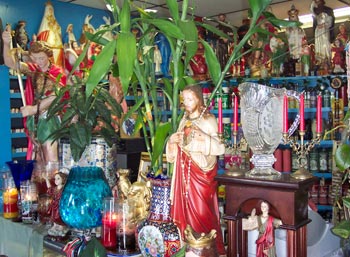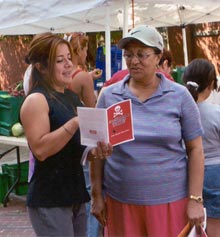The Ritual Uses of Mercury
Air Date: Week of August 13, 2004
Mercury has been used for thousands of years in medicine. The metal has even been ascribed magical properties. Today, though, it's known for its toxicity. But the use of mercury in ritual has persisted in some communities here in the US. Living on Earth's Cynthia Graber reports.
Transcript
CURWOOD: Mercury has played a role in human culture for thousands of years. It’s the only metal that’s a liquid at room temperature. People have long attributed medical, or even magical, powers to it. But its ability to harm the human brain has been known for more than a hundred years. Probably the most famous example is the Mad Hatter from Alice in Wonderland – “mad” because he worked with mercury.
Scientists and advocates alike have sought to remove mercury from the food we eat and the air we breathe. So health workers in the Boston area were surprised when they found out that the idea of a beneficial mercury has persisted in some communities. Cynthia Graber reports.
[CHATTER OF ELDERLY VOICES, SPEAKING IN SPANISH]
GRABER: Seniors fill a community room in downtown Lawrence, Massachusetts, a former mill town about an hour northwest of Boston that’s now 80 percent Latino, mostly Dominican. Doris Anziani heads up a local environmental health group called Casa de Salud that offer regular “charlas,” or chats, such as the one here today. At one charla last spring, Anziani spoke about the risk of mercury from incinerators and from certain kinds of fish. She mentioned that there’s mercury in thermometers. After she spoke, another Casa leader approached her.
ANZIANI: When she thought about that she said, “ooh, I’ve seen something else that looks like the liquid that’s inside the thermometer.” So we were asking her, “what is it?” “It’s in a capsule, and it’s sold at the botanicas. It’s called azogue.”
GRABER: Botanicas are stores that sell all sorts of Afro-Caribbean products: rosaries, saints, candles and perfumed water, and herbs. Anziani discovered azogues is another name for mercury.
|
ANZIANI: Then we came back to the Casa leaders and they were familiar with the mercury. People use it for these purposes. And we’re like, “okay, we need to do more research here. I think we’re not just being contaminated by the incinerator. I think we’re contaminating ourselves by using these products in our homes.” GRABER: Casa de Salud was founded by JSI, a group that does health research and training around the world. After their initial investigation, Anziani and her supervisor at JSI created a questionnaire to find out just how many people were using mercury in their homes. Community members, including teenagers, went around Lawrence, talking to people at home, in botanicas, in beauty salons and barbershops. ANZIANI: We discovered that out of 920 people, 40 percent had used it or knew someone that used it. So, it was very alarming. GRABER: Rosa Diaz, not her real name, reluctantly agrees to talk about her experiences with mercury. Diaz looks away and fidgets a little as she explains that she used to use mercury back in the Dominican Republic. [DIAZ SPEAKING SPANISH] VOICEOVER: I do remember once, I put it on, like for one month, almost every day, in perfumed water. All over my body, yeah. GRABER: Diaz used it in other ways, as well. [DIAZ SPEAKING SPANISH] VOICEOVER: And in the house, many people sprinkle it in the house. I used it in the house, too. GRABER: Diaz doesn’t want anyone to know she formerly used mercury. She stopped using it entirely when she moved to the U.S. nine years ago. She says it just wasn’t a part of her new life. Diaz only learned a couple of months ago about the damage mercury can cause. [DIAZ SPEAKING SPANISH] VOICEOVER: Oh, I wanted to die, because...that stuff – sometimes I tell people, be careful, because it really had a strong effect on me. Because I really forget everything. I can be studying, and I learn something today, and tomorrow I don’t know it. That could be from...when I was using it back then. GRABER: Scientists agree – the loss of memory she describes could well be due to the mercury vapors she inhaled. Many people have tales of playing with it as a child. The little balls of mercury roll around and vaporize. And it’s just this attribute that causes problems. Touching mercury isn’t really a concern because it’s not easily absorbed through the skin. But these vapors pass into blood and make their way to the brain. Symptoms of mercury poisoning include memory loss, irritability, anxiousness, tremors. Diaz used mercury for luck. But then she goes to the medicine cabinet to get out some face cream her sister brought her back from the Dominican Republic. DIAZ IN SPANISH: Mercurio oxido. GRABER: Wow DIAZ IN SPANISH: Tiene mercurio eso. GRABER: Yeah. GRABER: She discovered just this morning that it contains mercury oxide, a form of mercury. And the use of the metal extends beyond ritual and beyond cosmetics. [MERENGUE MUSIC] GRABER: Most agree that the spirited music and dance merengue came to life in the Dominican Republic. Both are intimately woven into the fabric and culture of the island. Sunilda Peguero, another Domican woman who lives in Lawrence, explains how the use of mercury is tied to the rhythm of the island. [PEGUERO SPEAKING SPANISH] VOICEOVER: I personally saw people there use that stuff. It’s a country where, you know, where people dance merengue, and people say it gives you more agility to dance -- especially in your hips, your whole behind. And that’s what it was for, that’s what we thought, that you could use it. Just the same way that mercury doesn’t lie calm – in that same way people, when they use it get in the groove and use it, they can really move. I didn’t have any knowledge that it can harm your body. I just didn’t know. GRABER: Peguero was willing to talk about what she saw other people do. And Diaz was willing to talk about her personal experiences – under an assumed name. But finding people willing to talk about using mercury here in the U.S., to outsiders, is difficult. In part, it’s because the use of mercury is also tied to Caribbean religions such as Santeria. And the religions themselves have been secret for hundreds of years. [CHANTING IN SPANISH, CALL AND RESPONSE] GRABER: Steve Quintana sways slightly as he leads the prayers in his Boston home, which is also a community house of worship. This evening, the room is overflowing with people of all ages, from small children in their mothers’ arms to grandparents. Quintana is a Santero, or a Santeria priest. The chants in the room hearken back beyond Quintana’s native Cuba to Santeria’s roots in Africa. Santeria, along with other Caribbean and South American religions such as voodoo, was an adaptation to life under slavery. Quintana says slaveholders tried hard to change the traditions of their slaves. QUINTANA: They went through a lot of trouble changing our language and adapting us to the ways of living, and put us into their own way of thinking. And giving us their own religion. And, eventually, we was hiding our religion under the table with the saints on top. GRABER: Today, Santeria – and its sister religions – are alive and well in Caribbean communities in American cities. In addition to leading ritual worship, Quintana also acts as a healer. He says he works with nature’s powers, and with herbs. He considers mercury powerful. But he says he would never recommend its use because mercury is toxic. QUINTANA: That’s the reason why I don’t sell that. And I would not sell that. GRABER: Quintana says that people do come to him requesting mercury. But he insists that mercury use was never a part of traditional Santeria. Rosa Diaz had a different experience in the Dominican Republic where she grew up. [DIAZ SPEAKING SPANISH] VOICEOVER: The majority of the Santeros tell you, “Use this for good luck.” GRABER: Though the use of mercury hasn’t been widely known in the U.S., it turns out a small group of researchers have been aware of its connection to Caribbean and Latin American communities. Linda Barnes is a medical historian associated with Boston University Medical School. She says slaves probably learned about mercury from their European slave owners and incorporated it into their own religions. Barnes explains that mercury was used in the U.S. and Latin America because of the strong reaction it produced in the body. BARNES: The core system was known as humoral medicine. And humoral medicine assumed there were a number of subtle fluids that ran through the body that influenced both a person’s temperament and personality, on the one hand, and their balance of health on the other. When that balance was out of kilter, physicians did things to try to rebalance it. Depending on the nature of the imbalance, you might let blood to reduce excessive heat, you might administer certain kinds of foods, certain kinds of herbs. And one of the things you might administer was mercury.
|

 Some Afro-Carribean stores or botanicas sell mercury in a variety of forms. (Photo: Courtesy of JSI)
Some Afro-Carribean stores or botanicas sell mercury in a variety of forms. (Photo: Courtesy of JSI)  Casa de Salud health care worker, Doris Anziani, talks to a woman about the dangers of mercury. Photo: Courtesy of JSI)
Casa de Salud health care worker, Doris Anziani, talks to a woman about the dangers of mercury. Photo: Courtesy of JSI) 



